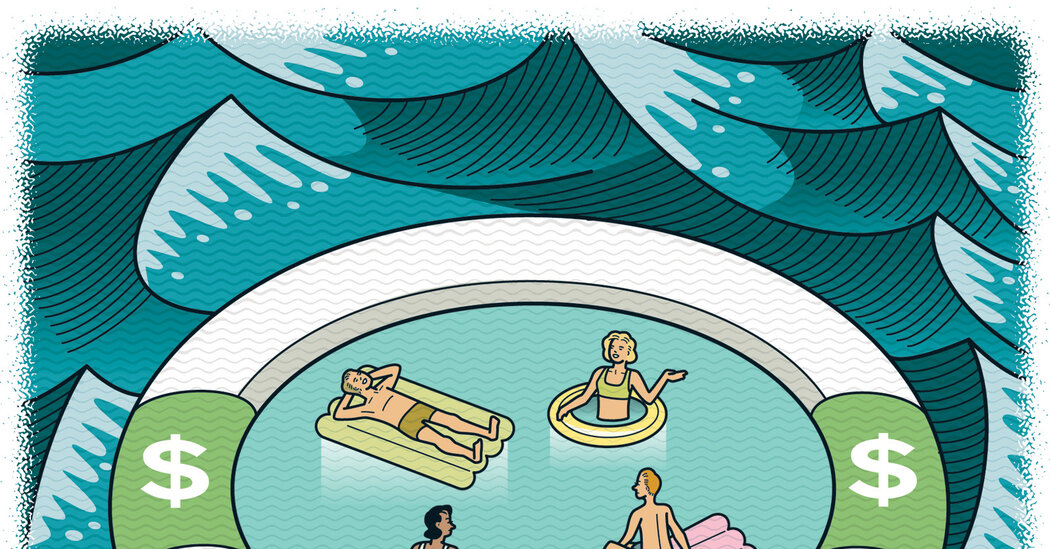Money market funds seem to be defying gravity. They are paying less in interest to investors, but becoming more popular.
Given a choice, people usually want more for their money, not less. Yet since the Federal Reserve began pushing short-term interest rates down more than a year ago, investors have been funneling hundreds of billions of additional dollars into these funds.
That may seem strange but there are good reasons for it. Thanks to a combination of convenience, good returns, and favorable comparisons with alternatives, money market funds are likely to continue attracting enormous wads of cash, even though the Fed announced on Wednesday that it was lowering short-term interest rates by a quarter of a percentage point.
Big money market funds have been paying more than 4 percent annualized interest, according to Crane Data, an independent financial market research firm. Within the next several weeks, these funds are almost certain to offer about a quarter of a percentage point less. But Peter G. Crane, a founder of Crane Data, is quite confident that their appeal will be undiminished.
“I expect about $100 billion to pour into money market funds each month for the rest of the year,” he said in an interview. “The funds will probably reach $8 trillion in assets by the end of this calender year,” up from around $7.8 trillion now, he said. “That’s very likely to happen, even though rates are going lower.”
Why the continuing popularity?
Basically, it’s because money market funds are still a good deal, even if they are no longer paying more than 5 percent interest, as many of the biggest funds did through much of last year.
The Returns
In certain periods, money market funds have been an effective stand-in for investment-grade bonds and bond funds, especially if you were looking for a stable and safe place for holding cash. We are living through one of those periods.
In fact, based on calculations done at my request by Jeffrey Ptak, managing director of Morningstar Research Services, money market fund returns — which roughly parallel those for Treasury bills — outperformed investment-grade bond funds over both the last five and 10 years through September.
That’s because bond funds lost value as inflation, and interest rates, rose sharply in 2022. (Bond prices and interest rates, or yields, move in opposite directions, and rising yields always hurt the values of bonds and of bond funds.) I wrote recently about the heightened volatility of bond funds in the past few years.
By contrast, short-term fixed-income instruments, like money market funds or Treasury bills (which expire, or “roll over,” in a matter of weeks and can be replaced by higher-yielding securities), excel under such conditions.
Those two disparate effects — damage to bond values and enhanced returns for money market funds — happened simultaneously in recent years, buffeting many portfolios.
Here are the five-year annualized returns through September:
-
S&P 500: 16.5 percent.
-
Bloomberg U.S. Aggregate Bond Index: -0.5 percent.
-
Money market funds (represented by an index of Treasury bills): 3 percent.
And here is how these asset classes fared, in annualized returns, over the 10 years through September.
-
S&P 500: 15.3 percent.
-
Bloomberg U.S. Aggregate Bond Index: 1.8 percent.
-
Money market funds (represented by Treasury bills): 2.1 percent.
Money market funds did better than bonds in both periods. Over five years, bond funds have lost value. Money market funds have had steady gains.
Don’t get too excited, though.
First, money market funds underperformed the S&P 500 by double-digits over both five and 10 years. They are liquid and handy places to store cash, but they aren’t great long-term investments.
Second, while stocks and bonds — which I hold in diversified, low-cost index funds — are often considered permanent parts of a classic investment portfolio, money market funds are different. They are prized for convenience, but have underperformed bonds over longer periods, and I expect that underperformance to happen again.
Recent History
There have been long stretches over the last 25 years — particularly after the financial crisis of 2007-8, and early in the Covid pandemic — when the Fed lowered short-term interest rates to near zero. In those periods, money market funds followed the Fed’s lead and paid investors almost nothing. I held my money in federally insured bank accounts in those years and shifted back into money market funds only when they began offering modestly attractive rates.
In June 2022, for example, when inflation peaked at 9.1 percent, big money market funds were paying only 0.6 percent interest. Even so, this was a big jump from virtually nothing, which had been the money market yield for more than two years. Back then, I pointed out that while we weren’t returning to the early 1980s — when money market rates soared above 15 percent, following the rate of inflation — it was highly likely that money market funds would soon become extremely popular again.
By early 2023, their yields surpassed 4 percent. Rates have begun falling, but the funds’ surging popularity isn’t over yet. We’ve been experiencing a gradual return to their traditional place as a useful part of an investor’s toolbox. They are not being marketed heavily because the better funds have extremely low expense ratios — the Vanguard Cash Reserves Federal Money Market Fund Admiral Shares fund charges just 0.1 percent — so they don’t generate much profit for their vendors.
But the funds are still catching on quietly. Mr. Crane expects them to keep growing until their yield drops below 3 percent. “That level seems to be an important level,” he said. It’s likely to get people to start thinking about whether it’s time to move their money elsewhere. At the moment, though, the Federal Reserve is projecting that its policy rate will drop no lower than 3.1 percent for the foreseeable future.
That could change suddenly, however, if the economy falls into a severe crisis and the Fed needs to slash interest rates radically. When that last happened, early in 2020, big corporations continued to use money market funds as yields dropped close to zero, but many individual investors abandoned the funds.
Banks offer Federal Deposit Insurance Corporation insurance, which money market funds don’t provide. While the funds have generally held up well through the financial crises of the last few decades, there have been some hiccups. On two brief occasions, for example, money market funds were unable to pay 100 cents on each dollar invested in them — they “broke the buck,” in Wall Street jargon. In the end, though, no significant losses occurred.
Take away money market funds’ superiority in yields and they would lose much of their appeal. It might make sense for some investors to lock in higher interest rates, now that short-term rates are falling.
The Outlook
For the immediate future, money market funds are likely to provide real value, with yields higher than the rate of inflation. The latest Consumer Price Index report showed that prices rose 3 percent annually in September. The Fed is trying to juggle two goals: curbing inflation, while supporting the labor market.
Money market funds would be well positioned if the Fed holds short-term rates above 3 percent, but it may not have that luxury. The Trump administration has been pressuring the central bank to lower rates more sharply, threatening the Fed’s independence, and investors will need to stay nimble.
The stock market is booming, but volatile. Nvidia, the premier artificial intelligence infrastructure company, reached $5 trillion in market value on Wednesday. It gained an astonishing $1 trillion in value in just four months.
The more extreme the stock market’s valuations, the more comforting it is to own an ample stash of cash. Still-handsome money market rates make holding cash even sweeter.
Jeff Sommer writes Strategies, a weekly column on markets, finance and the economy.
The post Interest Rates Are Falling. Why Are People Still Buying Money Market Funds? appeared first on New York Times.




